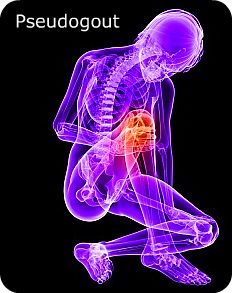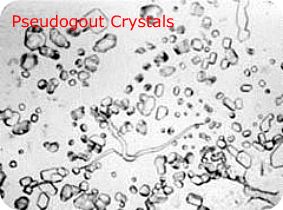[vc_row][vc_column 0=””][vc_column_text] Pseudogout is NOT the same thing as gout! Pseudogout, or CPPD disease, is a painfully disabling condition affecting millions worldwide. Because it is not very common, pseudogout is often the answer to many misdiagnosed and improperly managed forms of arthritis and gout.
Pseudogout is NOT the same thing as gout! Pseudogout, or CPPD disease, is a painfully disabling condition affecting millions worldwide. Because it is not very common, pseudogout is often the answer to many misdiagnosed and improperly managed forms of arthritis and gout.
If you’re asking, “what is gout” and trying to figure out whether you have gout or pseudogout, it can be tricky because the symptoms are almost identical. One of the ways to properly diagnose pseudogout is to have a doctor draw a sample of fluid from affected joint and look at it under a microscope.
You can see from pseudogout pictures this is not an enjoyable experience. However there is a simple way to give yourself a self-diagnosis at home, which I tell you about below under, How to Properly Diagnose Pseudogout.
Exactly What is Pseudogout?
The answer to the question, “what is pseudogout”, lies in the crystals. Gout and pseudogout attacks are both the result of specific and unique substances “crystallizing” in one or more of your joints. With gout, you have crystals from uric acid. With pseudogout, you have crystals from a salt called calcium pyrophosphate dihydrate (or CPPD for short). Hence, the proper term for pseudogout is CPPD Arthropathy.
These pseudogout crystals, or CPPD crystals, first get deposited in the soft cartilage surrounding a joint. Then these crystals get released, or knocked loose, from the cartilage (sometimes from during a sudden illness, joint injury, or surgery)…and then the crystals fall into the joint space.
Once the pseudogout crystals are inside the joint space, your body then mounts an inflammatory response…your joint gets swollen, red, hot to the touch, and very stiff and hard to move. This is exactly what a regular gout attack feels like, but instead this is a pseudogout attack.
Symptoms
Gout symptoms and pseudogout symptoms are remarkably similar, so much so that it is quite common for pseudogout to be mistaken for gout. The symptoms of pseudogout (and also the symptoms of gout) are as follows:
- The affected joint(s) becomes swollen, red, hot to the touch, and very stiff
- The attack can suddenly seem to come out of nowhere, leaving your wondering if you stepped off a curb wrong and twisted your ankle or knee
- After one attack ends, you can be asymptomatic (not have any pain) for months or years before you get another attack
- Sometimes the attack comes on very quickly, and is so excruciatingly painful you are forced to seek emergency help
- Other times, the attack can develop slowly over a few days before reaching peak intensity
- Sometimes the painful symptoms can last for months, despite the use of pharmaceuticals
- Both gout and pseudogout can be totally asymptomatic . . . meaning you’ve got the biochemical imbalance but you don’t get attacks, or flares. This may sound OK, but it’s not. This biochemical imbalance can lead to other life-threatening disease . . . yet you might not know you have it
Thus, if you have any of the above classic gout symptoms…be proactive and investigate whether you might actually be experiencing pseudogout symptoms due to CPPD arthropathy!
Who Gets It?
Pseudogout is a disease that mainly affects the elderly, although young adults can get it too. The prevalence of pseudogout or CPPD in the general population increases with age, such that 10-15% of adults are affected above the age of 65, with an increase to above 40% in elders over the age of 80.
Also, several large scale studies have found that the same numbers of men and women get pseudogout…it is an “equal opportunity” disease.
Pseudogout Knee
Pseudogout in knee joints is the most common location, followed next by the wrists, ankles, elbows, toes, shoulders and hips. Sometimes pseudogout can appear in a single joint, similar to septic arthritis and gout. At other times it can affect multiple joints all at the same time, similar to rheumatoid arthritis and osteoarthritis.
If you’ve been diagnosed for gout, but it always shows up in the knee…I suggest you ask your doctor to investigate whether you might have “pseudogout knee” or “CPPD knee”.
What Causes It?
Whereas gout causes are well known, unfortunately the western medical community does not know the exact cause of pseudogout, or CPPD disease. In the elderly, it seems to just come on with age without predictable triggers. However, in young adults there are 3 other medical conditions that have been found to commonly coexist with and possibly be causes of pseudogout, or CPPD arthritis:
- hyperparathyroidism – increased activity of the parathyroid gland that causes increased free calcium levels in the body
- acromegaly – an excess of growth hormone in the body that causes prominent jaw and enlarged hands and feet
- hemochromatosis – an excess of iron deposition in the body
However, in the world of Naturopathic Medicine and Traditional Chinese Medicine, pseudogout causes are fundamentally the same as gout causes, which are the same as every other disease: a state of biochemical imbalance. Once your body chemistry is brought back into balance, the disease will go away on its own. Below I will share with you a number of ways to treat pseudogout with holistic, naturopathic approaches.
The Crystals
 Several conditions can trigger the formation of pseudogout crystals, including:
Several conditions can trigger the formation of pseudogout crystals, including:
- Dehydration
- An attack of any severe illness
- Over-activity of the parathyroid glands (hyperparathyroidism)
- Long-term use of steroid medicine
- Underactive thyroid gland (hypothyroidism)
- Any cause of arthritis
- Haemochromatosis (an illness causing too much iron in the body)
- Wilson’s disease (an inherited illness causing a build-up of copper in the body)
- Acromegaly (an illness caused by an increased level of growth hormone in the body)
- Kidney dialysis
- Surgery or injury
- Low magnesium level in the blood (hypomagnesaemia)
Additionally, causes of pseudogout crystals can be due to increased levels of inorganic phosphate, leading to CPPD crystal deposition in the cartilage. And, the malfunctioning of the ANKH gene can also lead to increased formation of CPPD in the cells, as discussed below under, Is It Hereditary.
Is It Hereditary?
Numerous large scale studies have implicated a close relationship between genetic influences and pseudogout. The family-inherited form of the disease usually shows up when you are in your 30’s and 40’s.
The genetic basis of pseudogout has been linked to the ANKH gene, which controls a protein in the cell membrane that helps to transport inorganic pyrophosphate out of the cell. In other words, if this gene is mutated, the pyrophosphate (the PP in CPPD) can get stuck inside the cells. Thus, mutations of this gene can lead to familial forms of CPPD disease, or pseudogout.
Also, an association between osteoarthritis and pseudogout has been recognized, but the precise genetic mechanism remains unclear.
Misdiagnosis
Pseudogout disease, or CPPD disease, is often diagnosed incorrectly and thus treated incorrectly. First of all, the symptoms of gout and the symptoms of pseudogout are almost identical, so the two are often confused.
Pseudogout can be confused with the following forms of arthritis:
- Gout – which results from elevated levels of uric acid in the blood, due to either excess production or inadequate elimination of uric acid.
- Septic Arthritis – which is caused by an infection, and where the gram stain and culture test would be negative for Pseudogout and instead would show growth of some organism.
- Rheumatoid arthritis and osteoarthritis – which are autoimmune diseases that have signs and symptoms of joint inflammation.
How to Properly Diagnose Pseudogout
There are several ways to diagnose pseudogout, or CPPD disease, as follows:
- The Most Painful Way – Your doctor can draw a sample of synovial fluid from inside the affected joint and look at it under a microscope to see whether you have uric acid crystals or pseudogout crystals (calcium pyrophosphate dihydrate crystals, or CPPD crystals).
- The Expensive Way – You can have an X-ray taken and hope that your doctor will be able to see the calcium deposits, which sometimes are visible but not always.
- Another Expensive Way – You can have a CT scan (CAT scan) and hope that your doctor can detect any of the characteristic features of pseudogout joint damage, which sometimes are visible but not always.
- The Expensive and Unlikely Way – You can get a DECT scan (dual energy CT scan), which is a new diagnostic approach that can help differentiate between gout and Pseudogout. But this is so new it might not be available in your area, and your doctor might not know how to read the results.
- The Inexpensive and Painless Way – You can try a proven natural treatment for gout, using common grocery items, as described in my book Kill Your Gout NOW! If this works, then you can rest assured that you have regular ol’ gout . . . and thus you do NOT have pseudogout. And if my “Kill Gout FORMULA” does not work for you, then you may or may not have pseudogout and you should continue seeking conclusive diagnosis. And, by the way, I offer my book, Kill Your Gout NOW! for 20-bucks and a full money-back guarantee, so there is no risk for you to try this.
. . .
Hi Bert,
Just wanted to check in and let you know things are going pretty well. No major flare ups. Your advice has given me a new outlook on my health. I have not eaten any chicken meat or fish since Thanksgiving. I have lost around 30 lbs. and counting.(need about 100 more) But I am heading in the right direction. I have recently incorporated chia seeds into my diet and was wondering if you had an opinion of them. They seem to be at very least a great source of fiber.Thanks again
Jim
. . .
Alkaline Diet
The best diet for pseudogout is almost the same as the best diet for gout. I say “almost” because a gout diet includes the moderation of purine intake. Purine rich foods can lead to high uric acid levels. But for a pseudogout diet, you do not need to be concerned with limiting your purine intake, since pseudogout sufferers have no problems with either the production or elimination of uric acid.
So what is this diet for pseudogout? It is a comprehensive “lifestyle diet”. We are all so conditioned to see the word “diet” and think of food only. However, an effective pseudogout diet will include optimization of ALL the things you consume…water and other liquids, air, foods, toxins, stress, exercise and sleep. True natural health depends upon proper management of these 7 factors, with an emphasis on the acid/alkaline balance within each of them.
In his book “Alkalize or Die”, the world renowned doctor, Dr. Theodore Baroody,summed it up perfectly:
- “The countless names attached to illness do not really matter. What does matter is that they all come from the same root cause…too much tissue acid waste in the body!”
For this reason I recommend that you explore my 7-day online video-based program I call Kill Your Gout FOR GOOD. Even though I developed this program for addressing regular gout, it will work the same for pseudogout, because it is a comprehensive guide for how to bring your body chemistry to an appropriate state of acid/alkaline balance.
And, it is the opinion of many health practitioners that the acid/alkaline balance is the most important piece of the puzzle for achieving natural health, which would lead to the elimination of pseudogout.
Weston A. Price Diet
Another pseudogout diet recommendation is to focus on getting your calcium-to-magnesium ratios in balance. In order to be healthy, these two minerals need to exist in your blood in a certain proportional ratio to each other. In the case of pseudogout, it is well documented that there is an excess of calcium and a deficiency of magnesium.
And you must keep in mind that an excess of calcium is usually NOT from an excessive intake of calcium, but rather from the inadequate absorption of calcium. In other words, if the calcium in your dietary intake is not being properly utilized by the body, the calcium levels will build up in the blood stream.
- The best way to increase the utilization of calcium in the body is to consume raw milk, grass-fed beef, butter and fermented cod-liver oil.
On top of that many people do in fact have a deficient intake of dietary magnesium, which makes these 2 minerals exist in your blood in an unbalanced state. Magnesium is difficult to get from supplements in a form that is usable by the body. You need to get your magnesium from whole food sources. Some of the best sources of absorb-able magnesium are
- bran (rice, oats and wheat),
- seeds (squash, pumpkin and watermelon), and
- raw dark chocolate (In my opinion, chocolate tastes the best)
So, my recommendation is to eat more whole raw animal fats, in accordance with the Weston Price principals, and to eat more cold-pressed Xocai dark chocolate which is very high in bio-available magnesium.
Treatment
There are two types of treatment for pseudogout:
- Treating the Cause
- Treating the Symptoms
If you go searching around on the internet you will quickly find that all the “authoritative” sites like WebMd and Mayo Clinic will tell the only pseudogout treatment is to take anti-inflammatory drugs. While these drugs can be a god-send for temporary pain relief, they do NOTHING to address the underlying cause of pseudogout or prevent its recurrence.
The fact is, there are no pharmaceuticals that treat the root cause of pseudogout, because the western medical community really does not know what the root cause of pseudogout is. Thus, in order to treat the root causes of pseudogout, you must focus on creating balance and optimal health at a very holistic level. Ultimately, pseudogout is simply yet-another-disease that shows up as a result of overall poor health resulting from poor lifestyle choices.
Once more time, I have 3 recommendations for the treatment of pseudogout:
- First, get my program, Kill Your Gout FOR GOOD because it is a roadmap for how to create well-balanced holistic health (and it is a full money-back guarantee).
- Second, find yourself a local source of high-quality raw milk and grass-fed beef, which has the ample amounts of vitamins A and D that are required for proper calcium absorption and utilization.
- Third, start eating Xocai Chocolate 3 times per day in order to increase your magnesium levels.
+ Remember! When you apply a holistic treatment, pseudogout will gradually disappear and not come back.
++ References:
Announ N, et al, [Diagnosis and treatment of calcium pyrophosphate crystal-induced arthropathy]., Division de Rhumatologie, Hôpital Universitaire de Genève, 26 Avenaue de Beau-Séjour, 1211, Genève, Schweiz. Z Rheumatol. 2007 Nov;66(7):573-4, 576-8
https://www.ncbi.nlm.nih.gov/pubmed/17932681
Beyeler Ch. [Calcium pyrophosphate deposits–a chameleon]. Klinik für Rheumatologie und Klinische Immunologie/Allergologie, Universitätsspital Bern. Ther Umsch. 2002 Oct;59(10):523-8.
https://www.ncbi.nlm.nih.gov/pubmed/12428437
Richette P, et al. [Calcium pyrophosphate deposition disease]. Université Paris 7, UFR médicale, Assistance publique-Hôpitaux de Paris, hôpital Lariboisière, fédération de rhumatologie, 2, rue Ambroise-Paré, 75475 Paris cedex 10, France. pascal.richette@lrb.aphp.fr . 2011 Sep;40(9 Pt 1):856-64. doi: 10.1016/j.lpm.2011.03.015. Epub 2011 Jun 17.
https://www.ncbi.nlm.nih.gov/pubmed/21684108
PubMed Health – Pseudogout – Calcium pyrophosphate dihydrate deposition disease; CPPD disease
https://www.ncbi.nlm.nih.gov/pmc/articles/PMC2346483/
Macmullan P et al. Treatment and management of pseudogout: insights for the clinician. Ther Adv Musculoskelet Dis. 2012 Apr;4(2):121-31. doi: 10.1177/1759720X11432559.
https://www.ncbi.nlm.nih.gov/pmc/articles/PMC3383522/#bibr7-1759720X11432559
Oxford Journals – An update on the epidemiology of calcium pyrophosphate dihydrate crystal deposition disease
https://rheumatology.oxfordjournals.org/content/48/7/711.long
Charlene J. Williams et al. Autosomal Dominant Familial Calcium Pyrophosphate Dihydrate Deposition Disease Is Caused by Mutation in the Transmembrane Protein ANKH, Thomas Jefferson University, Philadelphia, PA, USA. Am J Hum Genet. 2002 Oct;71(4):985-91. Epub 2002 Sep 17.
https://www.ncbi.nlm.nih.gov/pmc/articles/PMC419998/
☆ SHARE THE LOVE!
☆ ☆ ☆
[/vc_column_text][/vc_column][/vc_row]

